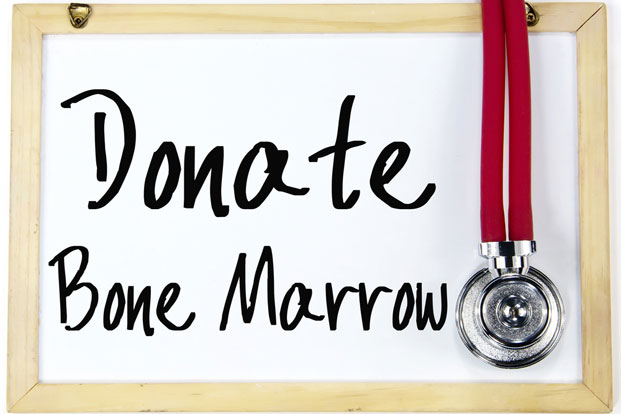Did you know that a bone marrow transplant can save a life?
Almost 20,000 people could benefit from potentially life-saving bone marrow or umbilical cord transplants annually. Unfortunately, experts report that 70 percent of those in need don’t have a bone marrow donor match in the family. This means they must rely on outside donors to receive the life-saving bone marrow needed.
Bone marrow is a spongy tissue that is located in certain bones, like the bones of your hips and thighs. Inside this material, stem cells can be found.
These cells develop into many life-sustaining substances. For example, they can become oxygen-rich red blood cells or immunity-boosting white blood cells. They can even become platelets, which are needed for blood to clot.
Experts say that two types of bone marrow exist in the human body. Red marrow produces red blood cells, white blood cells and platelets. However, the body also contains another type of bone marrow. That type of bone marrow is called yellow marrow. It is generally made up of fat cells.
Bone marrow changes color as we age. When we’re born and are young children, much of our bone marrow is red. But as we get older, about half of this bone marrow turns into yellow bone marrow.
Bone marrow is constantly at work. Experts say that every single day, the human body manufactures 200 billion brand-new red blood cells, white blood cells and platelets by way of bone marrow. Generally, 1 percent of these red blood cells are regenerated daily. Bone marrow even makes somewhere between 150,000 and 450,000 platelets for every microliter of blood in the body.
Bone Marrow-Threatening Diseases
Some diseases can affect our bone marrow. For example, leukemia causes bone marrow to create abnormal white blood cells. And another issue, called aplastic anemia, results in bone marrow that doesn’t manufacture red blood cells at all.
Other diseases can cause bone marrow to overproduce white blood cells. These issues are called myeloproliferative disorders. Lymphoma can cause a person to need bone marrow when it actually invades the bone marrow itself, thus hurting the body’s ability to make blood cells.
This is why bone marrow donation is essential for saving lives. Just 1 to 5 percent of a donor’s bone marrow is said to be needed to save a life.
How Does Donation Work?
When you decide to donate bone marrow to an unknown recipient, you are asked to join a registry. Doctors then will search for a match. This will be a donor that matches the recipient’s human leukocyte antigen (HLA) tissue type.
These are proteins located in the body’s cells that the immune system uses to differentiate between normal and abnormal cells. The doctor’s goal is to find a match between the patient and donor’s HLA markers, usually in someone of the same ethnicity. Once a match is found, bone marrow donation can take place.
However, the process of bone marrow donation isn’t as simple as other donations like whole-blood donation. Two types of bone marrow donations can be used. The first is called a peripheral blood stem cell (PBSC) donation. This is the most common procedure performed and does not involve surgery.
When a donor participates in a PBSC donation, a medication called filgrastim is injected into the donor for five days before the donation itself. This helps the body to create more cells needed for the transplant. In the process of the actual donation, blood is taken from the arm with a needle and then cycled into a machine that isolates the blood-forming cells. The rest of the blood then goes back into the body through the other arm.
The second type of donation, called bone marrow donation, is considered a surgical procedure. In other words, bone marrow is collected while a donor is under anesthesia in an operating room setting. Anesthesia is said to be the greatest risk of the process of bone marrow donation.
Once a patient is placed under anesthesia, the process of bone marrow donation can begin. To collect bone marrow, needles are used to obtain liquid marrow located in the back portion of the pelvic bone. It is then transplanted into a bone marrow recipient.
Be The Match reports that there can be some side effects associated with bone marrow donation. The most common of these is back and hip pain. Donors may experience fatigue and throat pain. Muscle pain, insomnia, headache, dizziness, nausea and a loss of appetite also may occur. However, patients generally recover fully in about three weeks or less.
The actual donation process is free. Be The Match reimburses travel costs and other costs associated with donation. Any costs associated with the procedure itself are covered by either Be The Match or the patient’s medical insurance. It does, however, cost $100 to register for the Be The Match Registry if you are 45 years of age or older because younger donors are most likely to be chosen.
If you don’t want to donate, there are still ways to help. Be The Match needs volunteers for several reasons. First, they aim to grow the registry of donors. So you can spread the word about the organization and the necessity of bone marrow donors. They also assist patients with the expense of the transplant itself, which means that financial donations are needed. (They also use money to advance the actual science associated with transplants.) Further, you can host a fundraising drive and even volunteer.
Are you ready to Be The Match? And tell others about the importance of bone marrow donation.

Leave a Reply